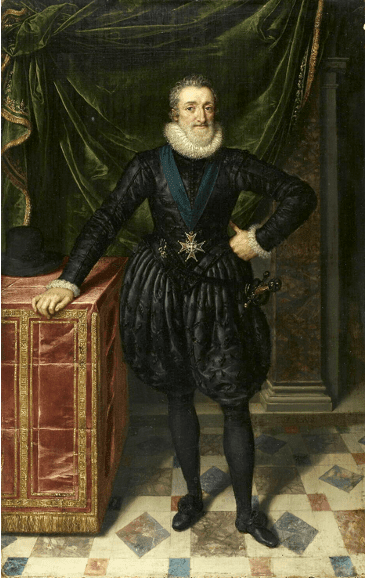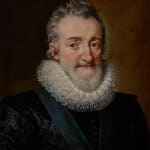 Fig. 1
Frans Pourbus II (1569 – 1622)
Fig. 1
Frans Pourbus II (1569 – 1622)Henri IV of France (1553 - 1610)
Oil on canvas: 62 x 50.7 cm.
Signed and dated: ‘F P FACIEBAT / ANNO 1610’
© The Royal Collection Trust (ref: CWLF 54).
 Fig. 2
Frans Pourbus II (1569 – 1622)
Fig. 2
Frans Pourbus II (1569 – 1622)Henri IV of France (1553 - 1610)
Oil on panel: 39 x 25 cm.
Signed and dated: ‘F. Porbus Fe. Ao 16[10 ?]’
© Musée du Louvre, Paris (inv. 1708, MR 926).
 Fig. 3
The present portrait shown hanging in one of the bedrooms in Hôtel Lambert, Paris.
Fig. 3
The present portrait shown hanging in one of the bedrooms in Hôtel Lambert, Paris.
 Fig. 4
Fig. 4Baptism of Princess Isabelle of Orléans, daughter of the Count and Countess of Paris,
in the Manoir d’Anjou, in 1933.
Copyright: Keystone-France/Gamma-Rapho via Getty Images.
Frans Pourbus the Younger (1569 – 1622)
Further images
Provenance
The sitter, thence by direct royal descent to
Louis Alexandre de Bourbon, Comte de Toulouse (1678 – 1737); to his son
Louis Jean Marie, Duc de Penthièvre (1725 – 1793); thence by descent to
Louis-Philippe I, King of the French (1773 – 1850), Château d'Eu; to
Henri, Comte de Chambord and Duke of Bordeaux (1820 – 1883); to his cousin
Prince Philippe d’Orléans, Comte de Paris (1838 – 1894), England; to his cousin
Prince Jean, Duke of Guise (1874 – 1940), Manoir d’Anjou, Woluwe-Saint-Pierre, Belgium; to his son
Henri d’Orléans, 2nd Comte de Paris (1908 – 1999), Manoir du Cœur Volant, Louveciennes; his sale [1]
Sotheby's, Paris, 29 September 2015, lot 1; where bt. by
Sheikh Hamad bin Abdullah Al Thani, Hôtel Lambert, Paris.
[1] The Orléans family collection had been the subject of a complete donation by Henri, Count of Paris (1908 – 1999), in favour of the Fondation Saint-Louis in Amboise. He had wished to disinherit all his children, however a justice decided to return to the heirs the "historic assets of the treasury of the kings of France" and, due to the number of beneficiaries, it was decided that the collection would be sold en masse in 2015.
The artist carefully renders his sitter’s spirit through lively blue eyes, which almost deliberately match l'Ordre du Saint-Esprit’s royal blue sash, and skilfully – diplomatically, even – articulates the king’s weathered, though undoubtedly leonine features. The present portrait’s provenance, it having remained in the Bourbon family for over four hundred years, infers that it must have been an important commission for the royal family.
As the first monarch within the (subsequently) longstanding Bourbon dynasty, Henri IV lacked a visual precedent for his court’s imagery. Unlike the ostentatious and other-worldly nature of his Habsburg counterparts’ visual identities within the arts, the Bourbons followed on from the simple elegance of their Valois predecessors, which had been crafted by François Clouet (c.1510 – 1572); forgoing obvious royal regalia for refined mode de jour. Frans Pourbus had already been patronised by the most culturally rich courts in Europe, starting in Brussels for the Governor Generals of the Spanish Netherlands, and then to Vincenzo Gonzaga’s court in Mantua, where he worked alongside Peter Paul Rubens (1577 – 1640). The artist had established the quintessential imagery for these most dignified and illustrious princely courts from a very young age, and his reputation was such in the early 1600s, that Marie de’Medici, sister to the Duchess of Mantua, Eleanor de’Medici (1567 – 1611), and Henri IV’s queen, purposefully sought out Pourbus to orchestrate a powerful visual legacy for France’s new royal family; to legitimise the Bourbon regime, as Clouet had for the Valois, having seen the direct effect Pourbus’s style of portraiture had on promoting the Mantuan court beyond its city walls.
Unlike the homogenous, easily replicated likenesses of other European heads of state, Pourbus was able to convey palpable individuality within his oil paintings; whether they were the successful Flemish merchants he first painted during his early life in Antwerp, or Dukes from the most ancient of noble families. So, despite the king’s elevated stature in society – notwithstanding his elegant attire - he is portrayed as Pourbus might paint any other subject; an air of grace and calm surrounds the king’s head, whilst great care has been used to render his curled greying hair and his distinctively large nose, complete with a skin tag. Bar the slashed black satin doublet and subtle blue sash, which signifies that the sitter is a member of l'Ordre du Saint-Esprit - the most prestigious order of chivalry in the France – one might not know that the sitter was the king of one of Europe’s most powerful nations.
No other portrait painter had such a revered international reputation, nor did France have their own native painter of comparable ability, so Frans Pourbus was the obvious choice to generate impressive and iconic portraits that were commensurate with the Bourbons’ new role as France’s monarchs. Beyond being their court painter, Pourbus was also a formal member of the royal household, being one of the king’s valued ‘valet de chambre’. Whilst some of the tasks, such as making the king’s bed, were rather menial, it gave him near-exclusive access to his royal benefactor and, clearly, he proved a valued advisor; his long-standing service to the court was formally recognised in 1617 when the artist became a naturalised French citizen. Pourbus was, thus, solely responsible for composing and generating the iconography for the early generations of Bourbons; indeed, the present portrait’s likeness of Henri IV, and others depicting his heir Louis XIII (1601 – 1643), are those that remain the most familiar visual representations of the monarchs today.
Born in Navarre in 1553, Henri was raised as a Protestant. In 1570, as a result of the temporary reconciliation between the Huguenots and the Catholic crown, Henri was betrothed to Marguerite de Valois, a sister of King Charles IX (1550 – 1574). However, not long after their marriage, the massacre of Saint Bartholomew’s Day took place.[1] Henri only managed to save his life by abjuring Protestantism, yet remained a virtual prisoner at court until 1576, when he escaped Navarre and returned to the Protestant faith. Henri became the legal heir to the French throne upon the death of Hercule-François, Duke of Alençon (1555 – 1584). The Catholic league refused to recognise a Protestant as heir, but, after the assassination of Henri III, they were defeated, and Henri IV became the first Bourbon king of France in 1594. The year before, as a conciliatory gesture to the dominating Catholic forces in French society, Henri again abjured Protestantism, famously quipping, “Paris is well worth a mass”; this act won him widespread support, as it was a palpable attempt to restore public confidence in the crown, which earned him the nickname of ‘le bon roi Henri’.
During his reign, Henri dedicated his efforts to the reconstruction of a kingdom that had been devastated by constant wars (himself having been a veritable warrior). This he did through the restoration of some financial stability and the expansion of agriculture and commerce, as well as propagating a more steady, trustworthy reputation for the royal family. With the Edict of Nantes in 1598, he established a progressive measure of tolerance and freedom for the Huguenots. For the remainder of his reign, Henri facilitated peace within France and enjoyed being celebrated as a ‘Gallic Hercules’.[2] Whilst proudly embracing and demonstrating the virtuous attributes of the ancient hero, he was also famous for indulging in earthly pleasures, particularly hunting, gambling, and womanising. Somewhat anticipating the trajectory of the Herculean myth - with the violent death of its hero - Henri’s previously cautious guard slipped the day after the belated coronation of his queen, Marie de Medici, in May 1610, when he was violently stabbed to death by a Catholic zealot, François Ravaillac.[3]
Due to its inscribed date and its remarkable royal provenance – remaining in the famille de France collection until 2015 - it is likely that our version was commissioned by another member of the royal family;[4] indeed, it is directly comparable to another variant in the British royal collection (Palace of Holyroodhouse, fig. 1), which was owned by Henri’s youngest daughter, Henrietta Maria (1609 – 1669). The present portrait also relates to a cabinet full-length portrait kept in the Musée du Louvre (fig. 2), which was purportedly painted a few months before the king's assassination on 14 May 1610.
For all of these variants to have been painted in 1610, which was arguably the most momentous year associated with Henri’s life, it seems likely that one composition was conceived before his death in May of that year and the others produced posthumously to commemorate his tragic death. One could argue, due to it having been gifted to his youngest daughter, who was only a baby when her father was murdered, that the variant in the Royal Collection was painted with Henri’s loss in mind. Notwithstanding the possible circumstances of its commission, i.e. to commemorate a lost parent, Henri’s head has a more generalised, mask-like quality compared to the present portrait, which has a more vibrant, life-like appearance. That the same modelled likeness is used in the Louvre’s cabinet full-length, might infer that the present portrait is the prime version, from which all other derivative portraits were referenced.
[1] This was an orchestrated massacre of French Huguenots (i.e. Protestants) in Paris in late August 1572, which was plotted by the Queen of France, Catherine de' Medici (1519 – 1589), and carried out by Roman Catholic nobles and other citizens. It was one event in the series of civil wars between Roman Catholics and Huguenots that beset France in the late 16th century.
[2] E.H. Dickerman, Edmund H, “The Choice of Hercules: Henry IV as Hero” from The Historical Journal, vol. 39, no. 2, 1996, p. 325.
[3] Ravaillac was a recluse who found solace in profound religious extremism, which included violent visions. He imagined himself chosen by God to convince the king to force France’s Huguenots to convert. Thwarted in his attempts to tell the king his prophetic message, Ravaillac thought Henri had actively rejected him. He interpreted the king’s willingness in early 1610 to go to war in the Netherlands as Henri’s decision to make war on the pope and, thus, envisioned himself as God’s instrument in defending France from this evil action. He was immediately arrested and later executed in central Paris.
[4] This celebrated collection was passed down from the Comte de Toulouse, son of Louis XIV and the Marquise de Montespan, to his son, the Duc de Penthièvre, then by descent to King Louis-Philippe, who was a great collector of portraits. The collection later passed to the Comte de Chambord, grandson of Charles X, then to his cousins in the d'Orleans family, who lived in England during the Third Republic. A few decades later, the collection joined the collection of the Duc de Guise before, finally, the second Comte de Paris installed the collection in the Manoir du Cœur Volant at Louveciennes.







